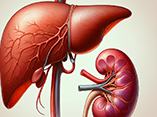Effect of Different Vaccines and Aluminum Nanoparticles (ALNPs) on Liver and Kidney of Rabbits
DOI:
https://doi.org/10.31661/gmj.v14i.3677Keywords:
Aluminum nanoparticles, vaccine adjuvants, histopathology, liver toxicity, kidney toxicity, nanoparticle safetyAbstract
Background:
Aluminum nanoparticles (ALNPs) have gained attention as potential vaccine adjuvants due to their immunostimulatory properties. However, their impact on organ health remains a critical concern. This study examines the histopathological effects of ALNP-based vaccination compared to conventional aluminum-adjuvanted vaccines, focusing on liver and kidney tissue alterations in rabbits.
Materials and MethodsA total of 30 male rabbits were randomly assigned to five groups (n=6 per group). The control group received normal saline (0.2 mL, IM). In contrast, the experimental groups received either ALNPs at low (0.05M, IM) or high (0.1M, IM) doses, or inactivated poliomyelitis (0.2 mL, IM) or diphtheria-tetanus-pertussis (DTP) vaccine (0.2 mL, IM). A single dose was administered, and histopathological assessments of liver and kidney tissues were conducted after a 30-day observation period.
ResultsALNP exposure resulted in significant histopathological damage, with the high-dose ALNP group exhibiting renal tubular necrosis, glomerular swelling, intertubular hemorrhage, and hepatocyte degeneration. The vaccine groups also showed notable but comparatively less severe pathological changes, including moderate hepatocyte degeneration and renal tubular apoptosis. The control group exhibited normal histological structures.
DiscussionThe findings indicate that while both ALNPs and conventional aluminum-adjuvanted vaccines induce organ toxicity, ALNP exposure leads to more pronounced tissue damage. The extent of histopathological alterations suggests a dose-dependent effect, raising concerns about the safety of ALNPs as vaccine adjuvants. These results align with previous studies highlighting aluminum toxicity but underscore the need for further research into nanoparticle-specific mechanisms of tissue injury.
This study provides comparative evidence of ALNP and vaccine-induced histopathological alterations in liver and kidney tissues. The severity of damage associated with ALNP exposure necessitates further investigation into their long-term safety and biocompatibility. Future studies should explore alternative nanoparticle formulations with reduced cytotoxicity while maintaining immunogenic benefits.
References
Kayser V, Ramzan I. Vaccines and vaccination: history and emerging issues. Human vaccines & immunotherapeutics. 2021 Dec 2;17(12):5255-68.
https://doi.org/10.1080/21645515.2021.1977057
PMid:34582315 PMCid:PMC8903967
Kallerup RS, Foged C. Classification of vaccines. InSubunit vaccine delivery 2014 Nov 1 (pp. 15-29). New York, NY: Springer New York.
https://doi.org/10.1007/978-1-4939-1417-3_2
Moni SS, Abdelwahab SI, Jabeen A, Elmobark ME, Aqaili D, Gohal G, Oraibi B, Farasani AM, Jerah AA, Alnajai MM, Mohammad Alowayni AM. Advancements in vaccine adjuvants: the journey from alum to nano formulations. Vaccines. 2023 Nov 9;11(11):1704.
https://doi.org/10.3390/vaccines11111704
PMid:38006036 PMCid:PMC10674458
Mold M, Shardlow E, Exley C. Insight into the cellular fate and toxicity of aluminium adjuvants used in clinically approved human vaccinations. Scientific reports. 2016 Aug 12;6(1):31578.
https://doi.org/10.1038/srep31578
PMid:27515230 PMCid:PMC4981857
Vecchi S, Bufali S, Skibinski DA, O'hagan DT, Singh M. Aluminum adjuvant dose guidelines in vaccine formulation for preclinical evaluations. Journal of pharmaceutical sciences. 2012 Jan 1;101(1):17-20.
https://doi.org/10.1002/jps.22759
PMid:21918987
Miller NZ. Aluminum in childhood vaccines is unsafe. Journal of American Physicians and Surgeons. 2016 Dec 22;21(4):109-6.
Gupta RK. Aluminum compounds as vaccine adjuvants. Advanced drug delivery reviews. 1998 Jul 6;32(3):155-72.
https://doi.org/10.1016/S0169-409X(98)00008-8
PMid:10837642
Chen C, Xue C, Jiang J, Bi S, Hu Z, Yu G, Sun B, Mao C. Neurotoxicity profiling of aluminum salt-based nanoparticles as adjuvants for therapeutic cancer vaccine. The Journal of Pharmacology and Experimental Therapeutics. 2024 Jul 1;390(1):45-52.
https://doi.org/10.1124/jpet.123.002031
PMid:38272670
Hamza Fares B, Abdul Hussain Al-tememy H, Mohammed Baqir Al-Dhalimy A. Evaluation of the Toxic Effects of Aluminum Hydroxide Nanoparticles as Adjuvants in Vaccinated Neonatal Mice. Archives of Razi Institute. 2022 Feb 1;77(1):221-8.
Bancroft JD, Gamble M. Theory and practice of histological techniques. Elsevier health sciences; 2007.
Pandey P, Dahiya M. A brief review on inorganic nanoparticles. J Crit Rev. 2016;3(3):18-26.
Jarrar BM, Taib NT. Histological and histochemical alterations in the liver induced by lead chronic toxicity. Saudi journal of biological sciences. 2012 Apr 1;19(2):203-10.
https://doi.org/10.1016/j.sjbs.2011.12.005
PMid:23961180 PMCid:PMC3730883
Johar D, Roth JC, Bay GH, Walker JN, Kroczak TJ, Los M. Inflammatory response, reactive oxygen species, programmed (necrotic-like and apoptotic) cell death and cancer. Roczniki Akademii Medycznej w Bialymstoku (1995). 2004 Jan 1;49:31-9.
Zusman I, Kozlenko M, Zimber A. Nuclear polymorphism and nuclear size in precarcinomatous and carcinomatous lesions in rat colon and liver. Cytometry: The Journal of the International Society for Analytical Cytology. 1991;12(4):302-7.
https://doi.org/10.1002/cyto.990120403
PMid:2065554
Gerlyng P, Åbyholm A, Grotmol T, Erikstein B, Huitfeldt HS, Stokke T, et al. Binucleation and polyploidization patterns in developmental and regenerative rat liver growth. Cell proliferation. 1993 Nov;26(6):557-65.
https://doi.org/10.1111/j.1365-2184.1993.tb00033.x
PMid:9116122
Yuan G, Dai S, Yin Z, Lu H, Jia R, Xu J, et al. Toxicological assessment of combined lead and cadmium: Acute and sub-chronic toxicity study in rats. Food and chemical toxicology. 2014 Mar 1;65:260-8.
https://doi.org/10.1016/j.fct.2013.12.041
PMid:24394482
Devadasu VR, Bhardwaj V, Kumar MR. Can controversial nanotechnology promise drug delivery?. Chemical reviews. 2013 Mar 13;113(3):1686-735.
https://doi.org/10.1021/cr300047q
PMid:23276295
Tang S, Chen M, Zheng N. Sub‐10‐nm Pd Nanosheets with renal clearance for efficient near‐infrared photothermal cancer therapy. Small. 2014 Aug;10(15):3139-44.
https://doi.org/10.1002/smll.201303631
PMid:24729448
Stuehr DJ, Nathan CF. Nitric oxide A macrophage product responsible for cytostasis and respiratory inhibition in tumor target cells. The Journal of experimental medicine. 1989 May 1;169(5):1543-55.
https://doi.org/10.1084/jem.169.5.1543
PMid:2497225 PMCid:PMC2189318
Renugadevi J, Prabu SM. Naringenin protects against cadmium-induced oxidative renal dysfunction in rats. Toxicology. 2009 Feb 4;256(1-2):128-34.
https://doi.org/10.1016/j.tox.2008.11.012
PMid:19063931
Ojo OA, Ajiboye BO, Oyinloye BE, Ojo AB, Olarewaju OI. Protective effect of Irvingia gabonensis stem bark extract on cadmiuminduced nephrotoxicity in rats. Protective effect of Irvingia gabonensis stem bark extract on cadmiuminduced nephrotoxicity in rats. 2014;7(4):1-7.
https://doi.org/10.2478/intox-2014-0030
PMid:26109902 PMCid:PMC4436210
Das S, Debnath N, Mitra S, Datta A, Goswami A. (2012). Comparative analysis of stability and toxicity profile of three differently capped gold nanoparticles for biomedical usage. Biometals.25:1009-1022.
https://doi.org/10.1007/s10534-012-9567-1
PMid:22752843
Terentyuk GS, Maslyakova GN, Suleymanova LV, Khlebtsov BN, Kogan BY, Akchurin GG, et al. Circulation and distribution of gold nanoparticles and induced alterations of tissue morphology at intravenous particle delivery. Journal of biophotonics. 2009 May;2(5):292-302.
https://doi.org/10.1002/jbio.200910005
PMid:19434616

Published
How to Cite
Issue
Section
License
Copyright (c) 2025 Galen Medical Journal

This work is licensed under a Creative Commons Attribution 4.0 International License.







